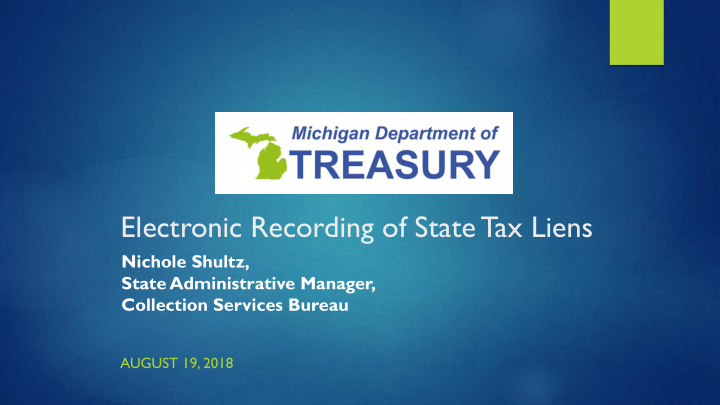



Electronic Recording of State Tax Liens Nichole Shultz, State Administrative Manager, Collection Services Bureau AUGUST 19, 2018
Prior to E-Lien project u File and release ~ 81,000 liens annually u Paper lien documents were mailed to 81 of the 83 counties and then mailed back to the State of Michigan (The two counties that E- filed accounted for approximately 25% of Collections lien document filings). u Not only did recording of a paper lien cause added steps, but the payment was also issued in paper check form causing additional manual steps for the county. u The lien release process could take up to 45 days.
Working with the Legislature u MCL 600.2567 Register of Deeds fees u MCL 211.685 State Tax Legislation Act u MCL 205.25 Revenue Division of Department of Treasury u The changes drastically increased the fees for recording documents with the county, but allowed us to pass the fees on to the taxpayer.
Paper Filing u Approximately 2,600 man hours annually to process liens. u Liens are printed once a week. u Two copies of each lien are printed, one for the taxpayer and one for the county. u The paper liens are manually counted by one unit to verify the correct total number of liens have printed. u The paper liens are then sent to another unit and sorted/counted by county. u The paper liens are then manually entered into the accounting system so a paper check can be prepared and sent, with the liens, to the appropriate county.
Paper Filing u County receives the liens and payment. Then they manually stamp the recording information on each lien and records the information in their system. Scan the paper and manually deposit the check into the bank. u Once recorded liens are mailed back to Treasury, Collections. They are manually counted to ensure all paper liens have been processed. u Once the liens are counted and verified by Treasury, Collections they are mailed, once a week, to our private collections vendor to enter the recording information in the State’s software program.
Problems with Paper u Cost of a manual process. u Errors from a manual process. u Not always having a matching number of liens printed to number of liens counted. (reconciliation issues.) u When a county rejects a lien there can be issues with refunding the recording fee. u Multiple units handling and sorting liens can lead to lost or misplaced paperwork.
Deciding to go Paperless u A feasibility study was conducted and determined it was not feasible to use a current e-lien process already in place with 2 Michigan counties. u Through the study a common vendor that facilitates paperless filings with various counties throughout the State of Michigan was identified. u Due to the extensive research conducted we were able to use a competitive, but streamlined, procurement process.
Going Paperless u One lien copy is still printed and mailed to the taxpayer. u Lien data is transmitted nightly to our lien vendor. u The lien vendor places data on our template and sends an electronic document to the county. u Payment is transmitted electronically with the filing document. u County receives the information electronically and records the lien electronically.
Going Paperless u The county sends an electronic document back to the lien vendor with the recorded information. u The lien vendor returns the documented file back to Collections via a secure portal. u Treasury, Collections retrieves the electronic document and uploads the information in the State’s software program.
Challenges u Getting the lien vendor to change the template to fit the statutory requirements for State of Michigan liens. u The added cost of paying the lien vendor to e-file liens. u Not all counties have signed up for, or have the ability to e-file liens. u Testing was difficult as it had to be coordinated with each county individually to ensure no inappropriate liens were filed.
E-Filing Successes u 95 % of real property liens are filed electronically. u From January 30, 2018 through April 30, 2018, 8,444 pieces of paper have been saved by not printing and mailing liens. This would equal annual savings of approximately $1,500 u 25 man–hours saved per week by reducing manual processing. Totaling approximately $60,000. u Payment of liens can be transmitted electronically in real time. u 93.4% reduction in customer wait time to receive officially recorded copies of lien documents, from 45 days down to 24-72 hours.
E-file Vs. Paper
E-File vs Paper
Questions?
Recommend
More recommend